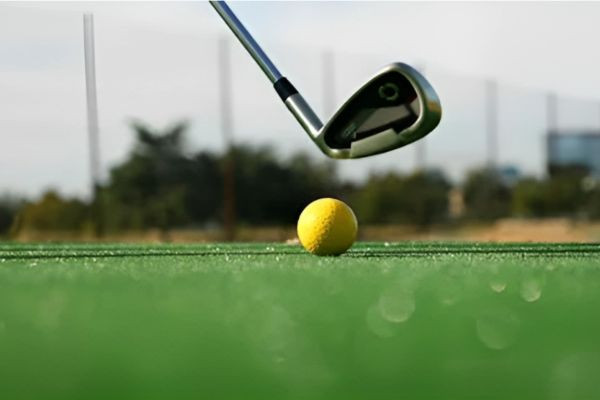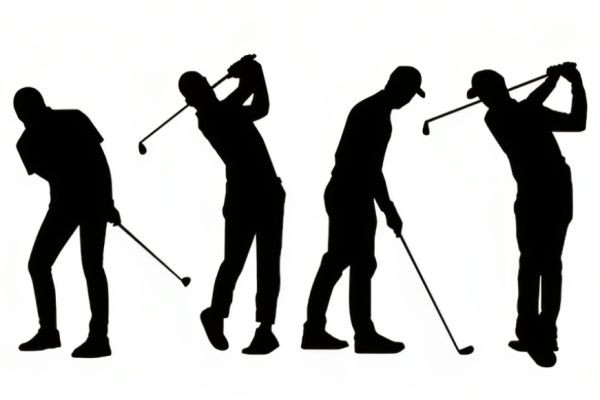Mastering Your Golf Swing Key Strategies for Perfecting Your Impact Position
Welcome to our in-depth exploration of one of golf's most critical aspects: the impact position. Mastering your impact position is often overlooked yet vital, which is the key to unlocking consistency..

Welcome to our in-depth exploration of one of golf's most critical aspects: the impact position. Mastering your impact position is often overlooked yet vital, which is the key to unlocking consistency and power in your golf swing. In this guide, we'll walk you through comprehensive strategies and drills designed to perfect this crucial element of your game.
Understanding the Impact Position
The impact position in golf is a critical moment that significantly influences the outcome of your shot. It is the point at which all the elements of your swing mechanics converge to connect with the ball. This moment is pivotal as it determines the ball's flight path, its distance, and the spin it will carry. Mastering a consistent and effective impact position clearly indicates golfing proficiency.
Several key elements characterize a good impact position. Firstly, your body alignment at this moment is crucial. Your hips, shoulders, and feet should be properly aligned to ensure a straight and targeted shot. Secondly, the position of the clubface at impact is vital. It should be square to the target line to ensure accuracy. The angle of the clubface also affects the ball's trajectory and spin.
Additionally, the speed and timing of your swing as the club makes contact with the ball play a significant role. These factors determine the power behind the shot and the subsequent distance the ball will travel. Moreover, the impact position affects the compression of the ball, which is essential for achieving the desired distance and flight path.
Achieving a consistently good impact position requires practice and a deep understanding of your swing mechanics. It involves coordinating the movement of different parts of your body and the club to create a harmonious and effective motion. This coordination is what enables skilled golfers to control their shots, maximize power, and improve their overall accuracy on the course.
Key Strategies for Improvement

1. Hips Movement:
Common Mistake: Often, golfers inadvertently thrust their hips forward toward the golf ball during the swing. This forward movement disrupts the swing's balance and reduces power. Instead of a fluid rotation, the hips move linearly, leading to a less efficient transfer of energy and a higher likelihood of mis-hits.
Correct Technique: The key is to focus on rotating your hips open during the downswing. This rotation should be smooth and controlled, initiating from the ground up. As your lower body initiates the movement, it creates a foundation for the upper body to follow, generating torque and allowing for a powerful, balanced swing. To practice this, you might use drills emphasizing hip rotation, such as swinging your feet together to encourage lower body stability and control.
2. Straight-Line Release Concept:
Definition and Benefits: This concept is about creating a synergistic alignment of your body parts during the swing. When your hips, shoulders, arms, and club are in a straight line, approximately 45° in front of the ball, it indicates that your swing is synchronized and efficient. This alignment ensures maximum power transfer and accuracy, as all parts of your body and the club are moving in unison towards the target.
Implementation: To integrate the Straight-Line Release into your swing, focus on drills that help you feel and understand the timing and coordination required. One effective drill is the "alignment stick drill," where you place sticks on the ground to visually guide the path of your hips, shoulders, and club. Practicing with these visual cues helps develop a sense of how to align your body correctly during the swing.
3. Upper Body Positioning:
Role of Left Pec and Bicep: As the hips begin to rotate, your upper body should naturally respond. The left pec and bicep play a significant role, especially for right-handed golfers, in ensuring the upper body follows the lower body in a coordinated manner. The left arm should stay connected to the torso, creating a feeling of compactness and control.
Torso Positioning: Emulate the stance of professional golfers by slightly opening your torso's rib cage at the point of impact. This open stance, typically around 20° to 30°, aids in ensuring that the upper body is actively participating in the swing, contributing to the overall power and direction of the shot.
4. Right Arm Dynamics:
Lag and Release: The concept of lag refers to the angle created between the right arm and the club shaft during the downswing for right-handed golfers. Maintaining this lag as long as possible and then releasing it effectively at impact is crucial for generating speed and power. The release should be a natural outcome of the body's rotation, not an isolated action of the hands or arms. Practice drills that focus on maintaining and then releasing lag can help you internalize this movement, making it an integral part of your swing.
Drills and Practice Techniques
To improve your golf game it's important to dedicate time to practice and incorporate drills that target aspects of your swing. Here's a closer look at how you can integrate these drills into your practice routine.
Enhancing Hip Movement:
Building a swing foundation starts with hip movement. To develop stability and power try incorporating drills that focus on hip rotation. One effective exercise is the "chair drill." Stand with your back against a chair and practice your swing while avoiding any contact with the chair. This drill helps maintain posture and encourages hip rotation without unnecessary forward movement.
Mastering the Straight-Line Release:
Proper alignment during your swing is crucial for achieving a consistent impact. Use alignment sticks as guides during practice sessions to ensure you're following the swing path. Place these sticks on the ground to mimic the desired alignment of your hips, shoulders and club.
This visual aid not only helps you understand the straight line release better but also gives you feedback on your swing path and body alignment. The objective is to develop a sense of how your body and club should be positioned at points throughout your swing.
Developing Upper Body Mechanics:
To effectively open up your chest and position your arms during the swing practice slow motion swings. This technique allows you to concentrate on the movement of your chest and arms ensuring that they synchronize properly with the rotation of your hips. By slowing down your swing you gain an understanding of each component's role and how they should feel at different stages of the swing. This intentional practice aids in ingraining the correct movement patterns into muscle memory.
Right Arm Dynamics and Lag:
The right arm plays a role in generating power and control in your swing. To enhance the dynamics of your arm in maintaining and releasing the lag incorporate specific drills that target this aspect.
One effective exercise you can do to improve your golf swing is called the "towel drill." For golfers you can hold a towel under your right armpit and practice your swings without letting it drop. This drill helps you keep your arm connected to your body, which in turn helps you maintain the lag. While swinging, focus on the sensation of releasing the lag at the moment of impact. This should happen naturally as your body rotates.
Common Mistakes to Avoid
It's important to be aware of mistakes that can hinder your progress when trying to perfect your golf swing. One major mistake is overcomplicating your thoughts while swinging. Many golfers tend to overload their minds with details, in an effort to improve resulting in a swing that feels forced and unnatural. Overthinking can disrupt the smoothness and rhythm necessary for a swing.
Instead try simplifying your approach. Golf is not about technique but about feel and flow. Concentrate on mastering the aspects of your swing and aim for a motion that feels effortless and rhythmic.
By adopting this approach you not only alleviate strain but also enable your body to discover its most effective and powerful swing trajectory.
Another frequent mistake is overlooking the significance of maintaining a practice regimen. Regular concentrated practice is crucial, for ingraining the mechanics into your muscle memory. Without it, your swing might be sluggish or irregular.
Lastly it's important to resist the urge to constantly modify your swing based on the tips or trends. While staying informed and learning from sources is beneficial, constantly changing your swing can lead to inconsistency and confusion. Instead find a technique that suits you well and stick with it making adjustments when necessary and based on informed decisions.
Conclusion
Enhancing your impact position goes beyond hitting the ball; it involves developing a powerful yet graceful swing. By practicing these strategies and being patient you'll notice improvements, in both your proficiency and enjoyment of golf.
Frequently Asked Questions (FAQs)
What is the impact position in golf, and why is it important?
The impact position refers to the moment when your club makes contact with the golf ball. It's a point where the mechanics of your swing determine factors such as trajectory, spin and distance of the ball. Achieving an effective impact position is vital because it directly influences the quality of your shot. It plays a role in improving control, power and accuracy in your game.
Ensuring an impact position is essential to transfer the energy generated in your swing, to the ball resulting in more precise and powerful shots.
How can I correct common mistakes in my hip movement during the swing?
To correct hip movement it's important to understand the distinction between thrust and rotational opening. Instead of pushing your hips towards the ball, focus on rotating them around your spine. This motion allows for a greater body engagement and contributes to a stronger and more balanced swing. You can reinforce this movement by practicing drills such as the chair drill, where you actively avoid making contact with a chair placed behind you. This rotational approach helps maintain stability while generating the torque for a swing.
What is the Straight-Line Release concept in golf?
The Straight Line Release is a technique that involves aligning your hips, shoulders, arms, and club in a straight line that extends about 45° ahead of the ball at impact. This alignment is crucial as it indicates an efficient swing, enabling power transfer and accuracy. Visualizing and achieving this posture can be aided by practicing with alignment sticks.
The objective is to achieve a cohesive and synchronized motion where every part of your body and the golf club work, in unison towards the target.
How do I improve my upper body positioning for golf?
Improving upper body alignment involves coordinating the movement of your chest and arms with the rotation of your hips. As your hips rotate your chest should open up while keeping your leading arm close to your body for control and strength. Engaging in slow motion swings can be advantageous as it allows you to concentrate on and feel the alignment of your body. This practice assists in comprehending how your upper body should move in relation to the rest of your body ultimately improving swing mechanics.
What role does the right arm play in the golf swing?
In a golf swing for right handed golfers the right arm plays a vital role, in generating power and controlling the trajectory of the club. The key lies in maintaining lag with your arm during the downswing and effectively releasing it at impact. This process of maintaining lag and then releasing it helps generate speed. Adds power to your swing. To improve your swing it's important to focus on maintaining the lag and on timing the release. One helpful drill, like the towel drill can make a difference in this aspect of your swing.
What are some common mistakes to avoid while improving my golf swing?
Avoid making mistakes such as overcomplicating your swing thoughts. Doing so can lead to an unnatural swing. Consistent practice is key for developing muscle memory and improving your swing mechanics. It's also important not to change your swing based on new tips or trends as this can disrupt your progress and lead to inconsistency. Instead concentrate on developing a fluid swing based on principles. Stick to a practice routine to gradually enhance your skills.
How long does it typically take to see improvements in my golf swing?
The time it takes to see improvement in your golf swing varies based on factors such as your starting skill level, the amount of practice you dedicate and how well you incorporate techniques into your swing. Some people may notice improvements within a week of practice while others may take longer. The key is dedicated practice along with patience, in refining aspects of your swing. With practice and a solid understanding of swing mechanics you'll experience sustainable progress.


